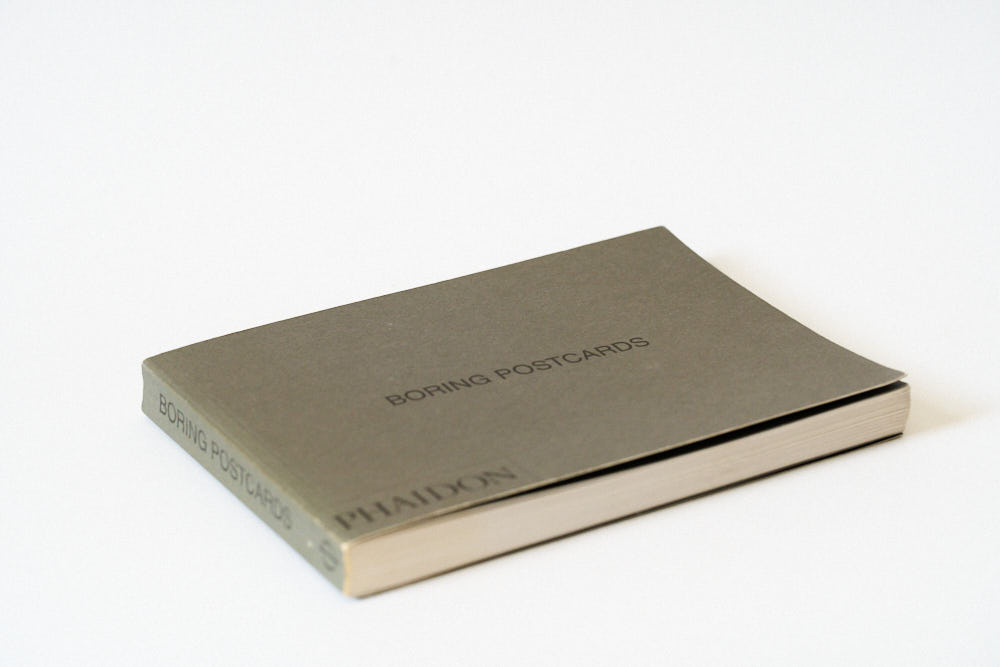My shelf controls the number of books I keep. And since I keep buying, I have to get rid of old ones. So time and again, I leaf through them, questioning which ones may stay.
So I encountered Martin Parr’s “Boring Postcards”1 again. The first book features historical postcards from Britain, the second one from the USA. Both paperbacks reprint cards that show sites from supposedly the second half of the twentieth century, but we never know exactly, for there is no context. All of the images focus on mundane public spaces: highways, intersections, shopping malls (interior and exterior), county halls, civic centres, libraries, baths, schools, industrial buildings, airports, hotels, and so on.

I remember being quite thrilled after having found them, mainly because they seemed to provide a pitch-perfect complement to Marc Augé’s “non-places,” another book I was reading at the time. (the early 2000s)2 To me, the postcards simply showed what Augé is writing about – transitory spaces of “supermodernity”, which are devoid of individuality, meaning, social bonds, history, etc.
So I was thinking of “Postcards” as an illustration of Augé’s text. Both were looking at similar spaces from a critical distance, marvelling at the new spaces. The topical intersection of both approaches sufficed to evoke a sense of shared intention — the difference being only in execution.
While I liked Augé’s text for secretly pointing at the inherent beauty of anonymity (which is, contrary to his intention, hidden beneath the negative assessments), I have never been really fond of Martin Parr’s pictures. I sense no love in them, only a vulgar gaze at the world’s strangeness and the people he photographs. And although there is always a split-second of astonishment, fascination, and even affection for the stuff he shows, the shame of being a gawker prevails (is that purposely so? Well, whatever).
“Boring Postcards” makes the matter even worse. Parr repeats his established photographic gesture — not by pressing his own camera’s button but by showing what the photographers and editors deemed worthy of publishing at the time.

Back then, »progress« through industrialisation was still a thing. Especially the USA book excessively revels in historical imagery depicting the joys and promises of 1950s capitalism. To be clear: there is nothing wrong with the single images – each is a unique and exciting document of the time, telling a story about what people were proud of and saw as a place’s signature of modernity.
The stink comes from amassing these pictures. In knitting long sequences of well-known motifs, Parr creates easy targets for us, the present spectators. Cars, motorways, shopping centers: by narrowing down the historical perspective to a panorama of transitory spaces, of mere infrastructure, the world can’t be anything but dismal.
But Parr may always hide behind the actual makers of the postcards: they made the decision to show this or that. It’s only the cultural subconscious of the time that manifests itself. Blah blah. The result is a whole otherworldly world in quotation marks.

Whereas Augé is trying to understand the anthropology of non-places – how they affect and position the individual –Parr creates another, new kind of displacement. The “Collection Martin Parr” operates like the worst in a natural history museum, disconnecting history from the present. The depicted sites appear as a thing of the past: been there, done that.
Whereas Augé is trying to understand the anthropology of non-places – how they affect and position the individual –Parr creates another, new kind of displacement. The “Collection Martin Parr” operates like the worst in a natural history museum, disconnecting history from the present. The depicted sites appear as a thing of the past: been there, done that.
Parr doubles down on the tourist’s perspective. In the past, each postcard tried to tell a story about local modernity, about the contemporariness of a place. Parr erases that gesture through seriality. In doing so, he creates the exact uniformity the book is mocking, hiding behind the as-is of the found footage.
Who’s boring now.
